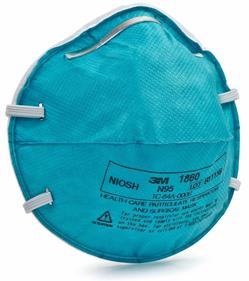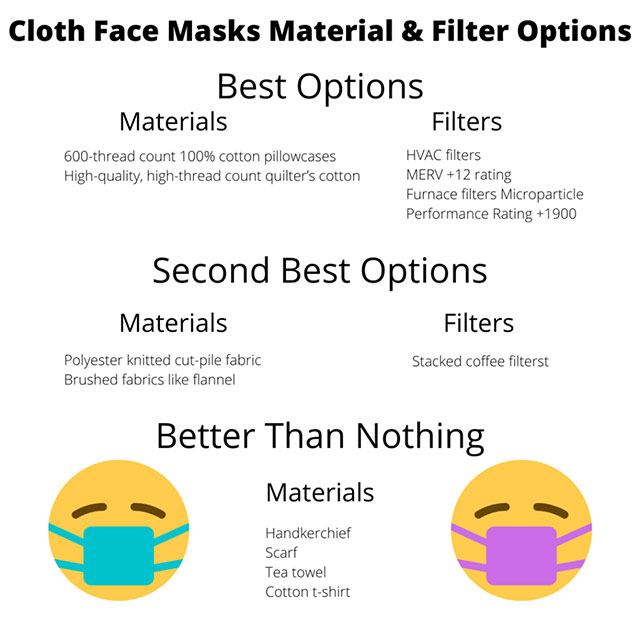
There’s been a lot of conflicting information floating about on the cloth mask effectiveness for pandemics like today’s COVID-19 coronavirus. The CDC reversed its stance on wearing cloth masks recently while the WHO has a slightly different viewpoint on who should be wearing masks. In both cases, it’s an about-face stance from where medical advice began – anything short of an N95 mask is useless, and even those have limitations.
Since N95 masks sold out so quickly, people have been scrambling to buy up alternatives, from PM2.5 anti-smog masks to disposable dust masks. Now people have begun sewing their own cloth masks. But are cloth masks effective?
Here are the main points on cloth mask effectiveness from both agencies.
WHO Cloth Mask Recommendations
- Do NOT wear a mask if you are healthy UNLESS you are caring for a person who is suspected of having the COVID-19 virus.
- If you are coughing or sneezing, wear a mask.
- Masks are ONLY effective when used in conjunction with frequent hand washing.
- If you wear a mask, it must be used and disposed of properly. (Source)
CDC Cloth Mask Recommendations
- Everyone should wear a cloth mask when they go out.
- Cloth masks should not be put on children younger than 2, nor anyone who has trouble breathing or incapacitated.
- Cloth masks are designed to protect others from contracting your infection, even if you have no symptoms, not to prevent you from getting sick.
- Do NOT use masks designed for healthcare workers because doing so reduces the supply available to them.
- Masks are NOT a substitute for 6-feet social distancing. (Source)
Cloth Mask Effectiveness
Overall, cloth masks are less effective in protecting against infection than surgical masks, which in turn are less effective than N95 masks. One study done on healthcare workers found that virus penetration of cloth masks was about 97% when compared to medical masks with a penetration of about 44%. Another study found that home-made cloth masks were the least effective in a comparison group made up of N95-equivalent masks, surgical masks, and cloth masks, only reducing particle infiltration by 1/5 overall.
CDC’s Reasoning
Since the CDC is recommending that everyone wear masks now, the question remains if cloth face masks are useful at all in stopping the spread of COVID-19. Well, according to scientists, “the answer depends on both the masks themselves and how infected individuals use them.” Notice that there is nothing said about cloth masks preventing infection in a healthy person wearing a mask. So if you wear a mask and think you won’t get sick because of that, well, that’s just simply not true.
The CDC’s reasoning behind wearing a cloth mask in public is the fact that asymptomatic infected people could be spreading the disease without knowing it. So if everyone wears a mask, the virus particles in the air are reduced because then those who are sick but aren’t aware of that fact aren’t passing it along.
A cloth mask will not prevent someone from contracting the disease when exposed to particles that have been deposited on surfaces or in the air. Nor are cotton or surgical masks particularly effective in stopping virus particles emitted by a coughing COVID-19 patient. The force of the cough pushes the disease-bearing bits through the mask and into the air. So having a sick person with a cough wear one doesn’t prevent the spread of the virus. Just so everyone is clear.
However, a cloth mask worn correctly by all members of the family, along with regular hand sanitizing and social distancing from the general population, can help reduce the chances of someone in your house contracting COVID-19.

Cloth Mask Materials
Cloth masks are only as effective as the materials they are made from. The best masks not only have multiple layers but an actual filter in the middle.
The CDC has information on making masks from material around the house. One method uses a bandana, aka handkerchief. However, four-layered masks made from woven handkerchief fabric have only a 0.7 percent filtration efficiency for the type of particles that are transmitting COVID-19, which is not very effective at all.
Cloth Mask Material Effectiveness
- One study rated material from a Hanes sweatshirt made of 100% cotton as providing sufficient filtration.
- Tea towels made from a cotton/polyester blend were also reasonably useful.
- Five-layer woven brushed fabrics like flannel have a 35.3 percent filtration efficiency.
- A woolen yarn scarf in four layers can filter nearly 50% as is four-layered polyester knitted cut-pile fabric, making these good options.
- A 600-thread count pillowcase used in four layers can capture almost 60%. High-quality, high-thread-count quilter’s cotton has been shown to be even better.
- Two-layer cloth masks made with this material were found to be as good as surgical masks, testing at nearly 80% filtration.
Unfortunately, the better filtration of a cloth mask also increases the difficulty a person has breathing while wearing it. For example, one mask that was tested was made from 16 layers of handkerchief fabric, which gave it a 63% filtration efficiency. Wearers found it nearly impossible to breathe with it on, and some even passed out.
Filters for Masks
Now, when you add a filter to all those layers, that’s when the protection level moves up. HEPA furnace filters, vacuum cleaner bags, and even coffee filters can reduce small particle transmission. Not just any filter will do, though. Many HEPA filters contain microscopic glass fibers, which are damaging to the lungs if inhaled. So before using either a vacuum cleaner bag or a furnace filter, check whether there are any fiberglass components.
Studies have shown that allergy-reduction HVAC filters can capture 94% of particles with two layers. A furnace filter needs six layers to reach 95% efficiency. Look for filters that have a minimum efficiency reporting value (MERV) rating of more than 12 or a microparticle performance rating more than 1900.
Three layers of coffee filters can filter about 40 to 50% of the virus particles. It’s hard to breathe wearing coffee filters, though, but knowing that it’s an option is good.

Proper Mask Fit
Even if a mask is made with the best materials available, if it does not fit the wearer well, particles containing the virus can escape through the gaps or if the method of tying is weak. Therefore, ties are better than elastic as a holding method because elastic can become loose over time. Surgical masks are made with elastic because they are meant to be thrown away after one use.
Wearer’s Behavior
How well a cloth mask reduces contagion is also affected by how a person puts it on, wears it, and takes it off. The multiple layers may cause breathing difficulty, which prompts the wearer to pull the mask down to breath, thus making the mask entirely ineffective. Moisture from the wearers’ breath is inevitable. The moisture buildup can become a contamination source for others when the mask is removed if it is not immediately disposed of.
The dampness caused by breathing also affects the filtering performance of the cloth as the threads swell. Cotton swells faster than synthetic materials. Washing also affects how tightly woven the fabric is, reducing efficiency.
The WHO has very clear guidelines on how to wear a mask.
- Clean your hands before putting on a mask.
- Cover your nose and mouth with the mask allowing no gaps between the mask and your face.
- Do not touch the mask when you are wearing it. If you do, wash your hands immediately.
- Replace the mask when it becomes damp.
- Remove the mask from behind. Do not touch the front of the mask. Discard the mask in a closed container.
- Immediately clean your hands.
Mask wearers may feel they are protected from the virus and engage in activities which they might not do if they were not masked. Bear in mind, that all the researchers agreed that while wearing a cloth mask may be better than nothing, it may not prevent either the wearer from adding virus particles to the air nor from inhaling virus particles emitted by someone else.
Therefore, the best solution in the case of COVID-19 is to continue hand washing and maintain appropriate social distancing no matter the type of mask you are wearing.
7 comments
If masks are only to prevent asymptomatic people from spreading the disease, why do they recommend:
* Do not touch the mask when you are wearing it. If you do, wash your hands immediately.
* Replace the mask when it becomes damp.
* Remove the mask from behind. Do not touch the front of the mask. Discard the mask in a closed container.
If you already have it why can’t you touch your own mask?
Nothing has been said about Maxi-Pads, Mini-Pads, LeakStoppers or the like – all available at $1.00 in the Dollar Tree. The pads may have handy adhesive for holding in place inside your mask and they are NOT impossible to breathe through. I was originally concerned about their contents and in several hours of searching – turned up NO bad ingredients (like fiberglas or rayon or some of the stuff you do not want in your air supply getting into your lungs. Cut open they look all cotton that is well contained.
Authors of ALL these articles. Could you all put the dates that these articles are written ? I really can’t find a date and these articles could be a year old or yesterday. Sure would appreciate it ! Thank you.
Thanks for the comment, Kath. There’s a debate over whether a blog owner should put dates on content or not. It’s generally considered unnecessary unless it’s a news-type site. I can understand why you’d want the date on this article, however (it was published in April 2020).
Thanks you, Derrick. And this is why I wished dates were applied. The article sounded like *yesterday’s* news, but could not be sure of it. Thanks you for responding. Have a great day!
Cloth mask do NOT stop or prevent the covid19 virus. Neither due the disposable surgical mask they are forcing people to wear. To compare the size of the virus 0.01 micro to the weave of a cloth mask is the same as the fence at the baseball field and you are holding a hand full of sand and throw the sand at the fence and tell me if it stopped it?
It’s 2023 and PPE can be bought for pennies on the dollar. I figured out how to make a N95+ mask out of a reusable particle mask using blue shop towels as the filters. It’s a straight forward design and anyone can make endless filters.
Particle Mask to Respirator Mask Modification N95+
https://www.instructables.com/Particle-Mask-to-Respirator-Mask-Modification-N95/